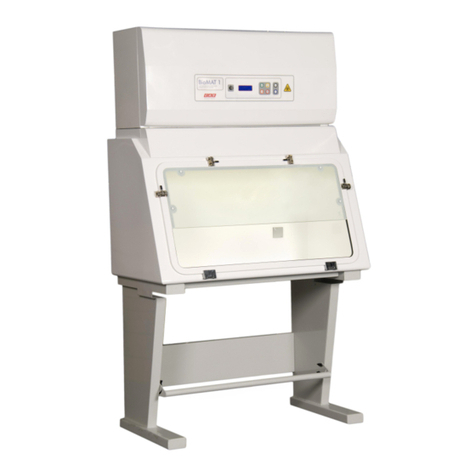
General Description –1.1
The BioMAT 2 Microbiological Safety Cabinet has been designed to provide optimum
performance for both operator and product protection. Using the latest developments in
microprocessor and fan technology, it is designed to exceed the performance requirements of
the European Microbiological Safety Cabinet Standard EN12469:2000. The safety cabinet
carcass and all seals are maintained under negative pressure ensuring air cannot leak out
during normal operation.
Class 2 Safety Cabinets offer both operator and product protection; they ensure that any
aerosols generated within the cabinet are filtered via high efficiency filtration (HEPA) prior to
being dispersed back into the laboratory or discharged to atmosphere. Operator protection is
provided by an air curtain across the working aperture in the front screen. Protection of the
products from external contamination is provided by a unidirectional downflow of sterile air
into the working area.
The Class 2 Microbiological Safety Cabinet can be supplied as standard in any of the following
three configurations:
Re-circulating Type –Air from the safety cabinet passes through two high
efficiency filters (HEPA) before being released back into the laboratory. The
exhaust air is made up of approximately 40% of the total air volume handled by
the safety cabinet. Approximately 60% of the air is re-circulated within the safety
cabinet and passes through a high efficiency (HEPA) filter to ensure sterility
within the work area.
Exhaust Type –Exhaust air from the safety cabinet is passed through a single
high efficiency filter (HEPA) before being dispersed to atmosphere via a fan
assisted extract system. The exhaust air is made up of approximately 40% of the
total air volume handled by the safety cabinet. Approximately 60% of the air is
re-circulated within the safety cabinet and passes through a high efficiency
(HEPA) filter to ensure sterility within the work area.
Thimble Type –Air from the safety cabinet passes through two high efficiency
filters (HEPA) before being discharged into an open duct, usually a specific
building extract system used to ensure laboratory extract & pressures are
maintained. This extract system is monitored via the safety cabinet controls, in
the event of an extract system failure the operator will be notified by an audible
and visual alarm on the cabinet. The exhaust air is made up of approximately
40% of the total air volume handled by the safety cabinet plus an amount of air
from the laboratory. Approximately 60% of the air is re-circulated within the
safety cabinet and passes through a high efficiency (HEPA) filter to ensure
sterility within the work area.





























